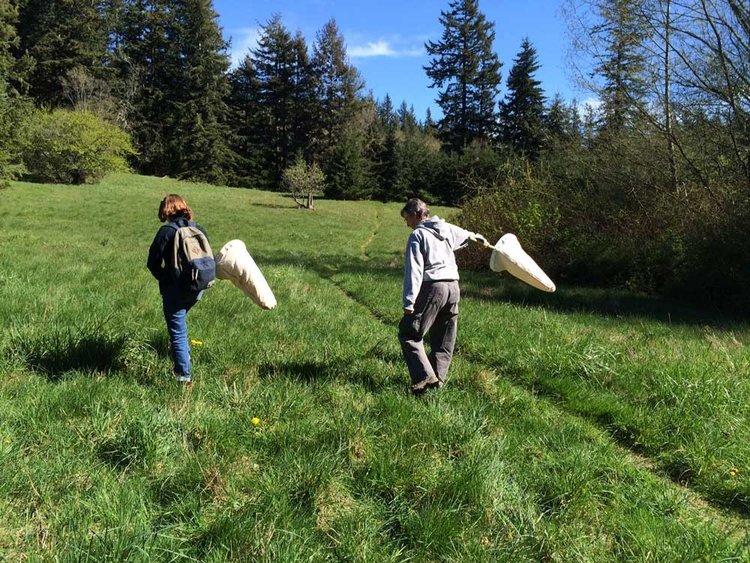Spider Collector's Journal
"From Rod Crawford's journal for collecting spiders for the Burke Museum"
30 III 2016: Jessi Bishopp was available to drive and collect for the first time this year, hooray! Laurel, back from Europe, was also available. The three of us fulfilled a long-time plan of mine by visiting Lummi Island, located between the San Juans and the coast of Whatcom County. A short but pricey ferry ride brought us to the island dock (site of the island's only public restroom, be warned!) where we met Leslie Dempsey and Bremyhr MacLaren of the Lummi Island Heritage Trust. They guided us to our first site, on a LIHT private conservation easement property near the NW coast of the island, where I wanted to supplement an old 11-species sample from nearby Clark Island. The site, reached by a short hike up a dirt road (Blizard Road), was a big grassy field/meadow surrounded by varied natural forest. Though the field is sometimes mowed for hay, habitats here were in great shape and we got 23 spider species (more than I needed) in a short time. No extremely rare species here, but several that we never found in our 5-hour visit to the second site. I was just about to move on when I crossed a sandy dirt path and found it occupied by a very flourishing solitary bee colony. Laurel joined me in snapping bee photos and spotted a couple of bee-flies flinging their parasitic eggs into the bees' burrows.
Next, we headed to the Heritage Trust's Curry Preserve (50 acres), which was a working farm not so long ago before the Trust acquired it, so the habitats are not in such great shape. Blackberry is almost everywhere, even though volunteers have cut down major thickets. The blackberry that remains doesn't really dominate any habitats, but it needs lots more work or it may do so someday. But it could be worse, at least we didn't see any ivy! We started up a forest trail from Tuttle Lane until we reached a large round former hayfield (the West Field) and mostly collected around there. Grass-sweeping produced varied spiders (introduced Tiso and Xysticus both prominent) with a Thanatus species, probably T. striatus, unusually common. Pardosa wolf spiders were active. A big detour took me around the field-edge blackberries to where I hoped to find litter under a couple of big maples. Well, I did find some litter but it was surprisingly sparse. I wonder if the deer (very common on the preserve) browse it, as they seem to do on nearby Orcas Island. Despite the sparse litter, sifting got me 9 species and bark on the ground yielded a couple more. Understory sweeping gave me uncommon Linyphantes eureka. While here, I heard a chainsaw somewhere NE of me, but blackberry in between kept me from investigating possible wood-poaching on the preserve.
Jessi had found an area with siftable moss on trees and logs down another trail, and this added 4 more species. Understory and cedar along other trails added a few more. Laurel and Jessi got a few introduced species in the public garden area near the old farmhouse; Laurel got the most interesting record of the trip here, third Washington record of introduced wolf spider Trochosa ruricola – then someone locked her in the fenced garden plot! After she escaped, we all met back in the west field to look for reachable Douglas-fir foliage, in very short supply due to the maturity of most fir trees and blackberry barriers around others. Laurel found the best fir branches, and between us we got 16 species from them, a very nice conclusion to a super-productive day; in all, we got 43 identifiable spider species from the Curry Preserve in about 5 hours. On the way back to the ferry we stopped briefly at the Congregational Church cemetery and beach trail, adding no more species but we got to see the Blizard family plot, proving that Blizard Road has nothing to do with snow!



